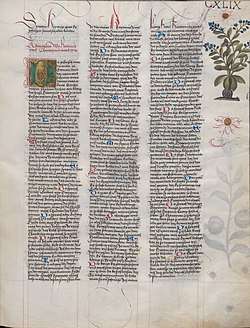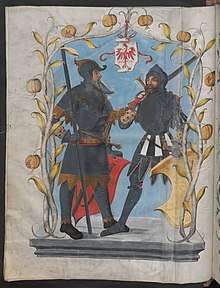Ambraser Heldenbuch
The Ambraser Heldenbuch ("The Ambras Castle Book of Heroes") is a 16th century manuscript written in Early New High German now held in the Austrian National Library (signature Cod. ser. nova 2663). It contains a collection of 25 Middle High German courtly and heroic narratives along with some shorter works, all dating from the 12th and 13th centuries.[1] For many of the texts it is the sole surviving source, which makes the manuscript highly significant for the history of German literature.[2] The manuscript also attests to an enduring taste for the poetry of the MHG classical period among the upper classes.[3]
| Ambraser Heldenbuch | |
|---|---|
| Austrian National Library, Cod. ser. nova 2663 | |
 Ambraser Heldenbuch, fol. 149r | |
| Date | 1517 |
| Language(s) | Early New High German (South Bavarian) |
| Scribe(s) | Hans Ried |
| Author(s) | Various |
| Illuminated by | Ulrich Funk or Veit Fiedler |
| Patron | Maximilian I, Holy Roman Emperor |
| Material | Parchment |
| Size | V + 238 folios |
| Format | 460 x 360 mm, 3 columns |
| Script | Chancery script |
| Contents | 25 works of narrative verse |
| Illumination(s) | Marginal decoration |
| Previously kept | Ambras Castle; Kunsthistorisches Museum, Vienna |
History
The manuscript was commissioned by the Emperor Maximilian I and written by Hans Ried in Bolzano over a period of years from 1504 to 1516.[1] It was originally kept in the Chamber of Art and Curiosities at Ambras Castle, near Innsbruck,[4], but in 1806, because of the uncertainty of the Napoleonic Wars, the Austrian Emperor Francis I had it moved to the Kunsthistorisches Museum in Vienna. After the First World War it was transferred to the Vienna Hof-Bibliothek ("Court Library"), which in 1920 became the Österreichische Nationalbibliothek ("Austrian National Library").[2][5]
Description

The texts are written on 238 folios of parchment — 476 pages, each 460 x 360 mm in size,[6] each folio numbered with Roman numerals in the top right-hand corner of the recto page.
Before the texts are four folios containing a list of contents and a separate sheet with a full-page illustration on the verso page showing two armed men beneath the arms of Tirol. These five additional sheets were added after the texts were completed and have been numbered I*–V*.[2] The table of contents provides cross-references to the folio numbers in the main body of the manuscript.
The works (all are verse) are set out as prose in a three-column layout, with a punctus (•) to mark the end of a line of verse, or, in many cases, a colon marking the end of a rhyming couplet. Decorated initial letters mark the start of a work or chapter of a work.[2] Lombardic capitals, alternating red and blue, indicate the start of a new strophe or section.[7]
Many pages have illustrations on the outer and bottom margins. The right-hand margin of folio 215r shows a naked woman playing a fiddle beside a shield with the date 1517 and the initials VF, which are assumed to be those of the artist, variously identified as Ulrich Funk or Valentin/Veit Fiedler.[8]
Contents

The works in the manuscript are grouped by genre: courtly narratives (including all of Hartmann von Aue's secular narratives), heroic epics (including the Dietrich and Nibelungen legends), and shorter narratives of a mainly didactic nature. The two final works, fragments of Wolfram von Eschenbach's Titurel and a German translation of the Latin Epistola presbiteri Johannis fall outside this scheme.[9]
The list of works below follows the order in the manuscript, giving the modern titles.[6] (The headings in the manuscript are descriptions of the work and do not match modern titles or indicate authorship.)[10]
Courtly narratives
- Der Stricker, Frauenehre (manuscript d)
- Moritz von Craon (sole surviving manuscript)
- Hartmann von Aue
Heroic epics
- Dietrichs Flucht (manuscript d)
- Rabenschlacht (manuscript d)
- Nibelungenlied (manuscript d)
- The Nibelungenklage (incomplete, manuscript d)
- Kudrun (sole surviving manuscript)
- Biterolf und Dietleib (sole surviving manuscript)
- Ortnit (manuscript A)
- Wolfdietrich A (sole surviving manuscript)
Shorter narratives
- Die böse Frau (sole surviving manuscript)
- Herrand von Wildonie
- Die getreue Ehefrau (sole surviving manuscript)
- Der verkehrte Wirt (sole surviving manuscript)
- Der nackte Kaiser (sole surviving manuscript)
- Die Katze (sole surviving manuscript)
- Ulrich von Liechtenstein, Frauenbuch (sole surviving manuscript)
- Wernher der Gartenaere, Meier Helmbrecht (manuscript A)
- Der Stricker, Pfaffe Amis (manuscript W)
Fragmentary texts
- Wolfram von Eschenbach, Titurel (fragment, manuscript H)
- Der Priester Johann (fragment, sole surviving manuscript)
Language
The language of the manuscript is Early New High German with some Bavarian features.[12] Thornton characterises Ried's language as "Tirolean written dialect of the age of Luther".[13] It is consistent with the language of the Habsburg Imperial Chancery, though there are some idiosyncratic spellings.[14]
In spite of the fact that Reid's texts must have come from a variety of sources, his orthography is relatively consistent between the individual works: variations between texts are minor, more likely reflecting gradual changes in his own orthography as the project progressed. This indicates that he must have made a conscious attempt to harmonise the spellings he found in his sources.[15]
Editions
There is no complete edition of the Ambraser Heldenbuch, though the University of Innsbruck has an ongoing transcription project.[16] In many editions of the individual texts the language of the 16th century manuscript has been adapted into the idealised classical Middle High German of the 13th century, as established by 19th century editors.[17]
Among the diplomatic editions of the texts are:
- Pretzel, Ulrich, ed. (1973). Moriz von Craûn. Altdeutsche Textbibliothek, 45 (4th ed.). Tübingen: Niemeyer. ISBN 348420069-3.CS1 maint: ref=harv (link) (parallel text with manuscript and normalised versions on facing pages)
- Hartmann von Aue
- Edrich, Brigitte, ed. (2014). "Hartmann von Aue: Erec, Handschrift A" (PDF). Hartmann von Aue Portal. Retrieved 17 February 2018.CS1 maint: ref=harv (link)
- "Transcription of the 'Klage' Österreichische Nationalbibliothek: Vienna, Austria. Manuscript A (Cod. vindob. ser. nova 2663, Bl. 22rc - 26va)". Hartmann von Aue Portal. Retrieved 24 February 2018.CS1 maint: ref=harv (link)
- Zutt, Herta, ed. (1968). Die Klage. Das (zweite) Büchlein aus dem Ambraser Heldenbuch. Berlin: de Gruyter.CS1 maint: ref=harv (link)
- Pritz, Roswitha (2009). Das Nibelungenlied nach der Handschrift d des "Ambraser Heldenbuch" (Codex Vindobonensis Ser. nova 2663, Wien, Österreichische Nationalbibliothek); Transkription und Untersuchungen (PhD). University of Vienna. Retrieved 24 February 2018.CS1 maint: ref=harv (link)
- Bäuml, Franz H., ed. (1969). Kudrun. Die Handschrift. Berlin: de Gruyter.CS1 maint: ref=harv (link)
- Ulrich von Lichtenstein (1993). Spechtler, Franz Viktor (ed.). Frauenbuch. Göppinger Arbeiten zur Germanistik, 520 (2nd ed.). Göppingen: Kümmerle. ISBN 3874527603.CS1 maint: ref=harv (link)
- Schnyder, André, ed. (1980). Biterolf und Dietleib. Sprache und Dichtung. Forschungen zur deutschen Sprache, Literatur und Volkskunde. 31. Bern, Stuttgart: Haupt.CS1 maint: ref=harv (link)
Notes
- Janota 1989, p. 323.
- Menhardt 1961, p. 1477.
- Gärtner 2004, p. 3033.
- Schloss Ambras Innsbruck.
- Österreichische Nationalbibliothek.
- Handschriftencensus.
- Hammer, Millet & Reuvekamp-Felber 2017, pp. xxvi.
- Janota 1989, p. 324.
- Janota 1989, p. 325.
- Menhardt 1961, gives all the headings.
- Traditionally regarded as an independent work, possibly by Heinrich von dem Türlin, recent scholarship sees it as a prologue to Hartmann's Erec. The manuscript treats them as a single text under a single heading. (Reuvekamp-Felber (2016))
- Hammer, Millet & Reuvekamp-Felber 2017, p. xxix.
- Thornton 1962. "Tiroler Schriftdialekt der Lutherzeit"
- Tennant 1985, p. 170.
- Tennant 1985, p. 173.
- Universität Innsbruck.
- Hammer, Millet & Reuvekamp-Felber 2017, pp. x–xii.
References
- Gärtner K (2004). "Grundlinien einer literarischen Sprachgeschichte des deutschen Mittelalters". In Besch W, Betten A, Reichmann O, Sonderegger S (eds.). Sprachgeschichte. 2.4 (2nd ed.). Berlin, New York: Walter De Gruyter. pp. 3018–3041. ISBN 3-11-018041-3.CS1 maint: ref=harv (link)
- Handschriftencensus. "Wien, Österr. Nationalbibl., Cod. Ser. nova 2663". Handschriftencensus. Retrieved 21 February 2018.CS1 maint: ref=harv (link)
- Hammer, Andreas; Millet, Victor; Reuvekamp-Felber, Timo, eds. (2017). Hartmann von Aue: Ereck. Textgeschichtliche Ausgabe mit Abdruck sämtlicher Fragmente und der Bruchstücke des mitteldeutschen ’Erek‘. Berlin, Boston: de Gruyter. ISBN 978-3-05-009551-6.CS1 maint: ref=harv (link)
- Janota J (1989). "Ambraser Heldenbuch". In Ruh K, Keil G, Schröder W (eds.). Die deutsche Literatur des Mittelalters. Verfasserlexikon. 1. Berlin, New York: Walter De Gruyter. pp. 323–327. ISBN 3-11-008778-2.CS1 maint: ref=harv (link) With bibliography.
- Menhardt, Hermann (1961). Verzeichnis der altdeutschen literarischen Handschriften der österreichischen Nationalbibliothek. Deutsche Akademie der Wissenschaften zu Berlin - Veröffentlichungen des Instituts für deutsche Sprache und Literatur; 13. 3. Berlin: Akademie Verlag. pp. 1469–1478. Retrieved 22 February 2018.CS1 maint: ref=harv (link)
- Österreichische Nationalbibliothek. "1920: Die Hofbibliothek wird Nationalbibliothek". Retrieved 22 February 2018.CS1 maint: ref=harv (link)
- Reuvekamp-Felber, Timo (2016). "Polyvalenzen und Kulturkritik. Zur notwendigen Neuausgabe des 'Erec' Hartmanns von Aue". In Auge, Oliver; Witthöft, Christiane (eds.). Ambiguität im Mittelalter. Formen zeitgenössischer Reflexion und interdisziplinärer Rezeption. Berlin, Boston: De Gruyter. pp. 219–237. ISBN 978-3-11-044224-3. Retrieved 26 February 2018.
- Schloss Ambras Innsbruck. "The History of Ambras Castle". Schloss Ambras Innsbruck. Retrieved 22 February 2018.CS1 maint: ref=harv (link)
- Tennant, Elaine C (1985). The Habsburg Chancery Language in Perspective. Berkeley, Los Angeles, London: University of California Press. pp. 165-173. ISBN 0-520-09694-0. Retrieved 1 March 2018.CS1 maint: ref=harv (link)
- Thornton, Thomas P. (1962). "Die Schreibgewohnheiten Hans Rieds im Ambraser Heldenbuch". Zeitschrift für deutsche Philologie. 81: 52–82.CS1 maint: ref=harv (link)
- Universität Innsbruck. "Ambraser Heldenbuch: Transkription und wissenschaftliches Datenset". Retrieved 24 February 2018.CS1 maint: ref=harv (link)
External links
- Digital facsimile at the Austrian National Library
- Hans Ried (Elaine C. Tenant, The Habsburg Chancery Language in Perspective)